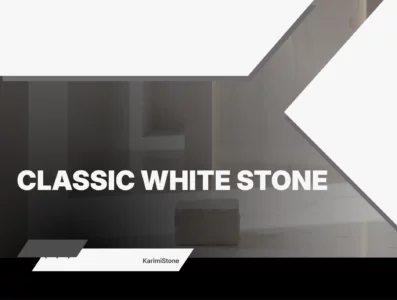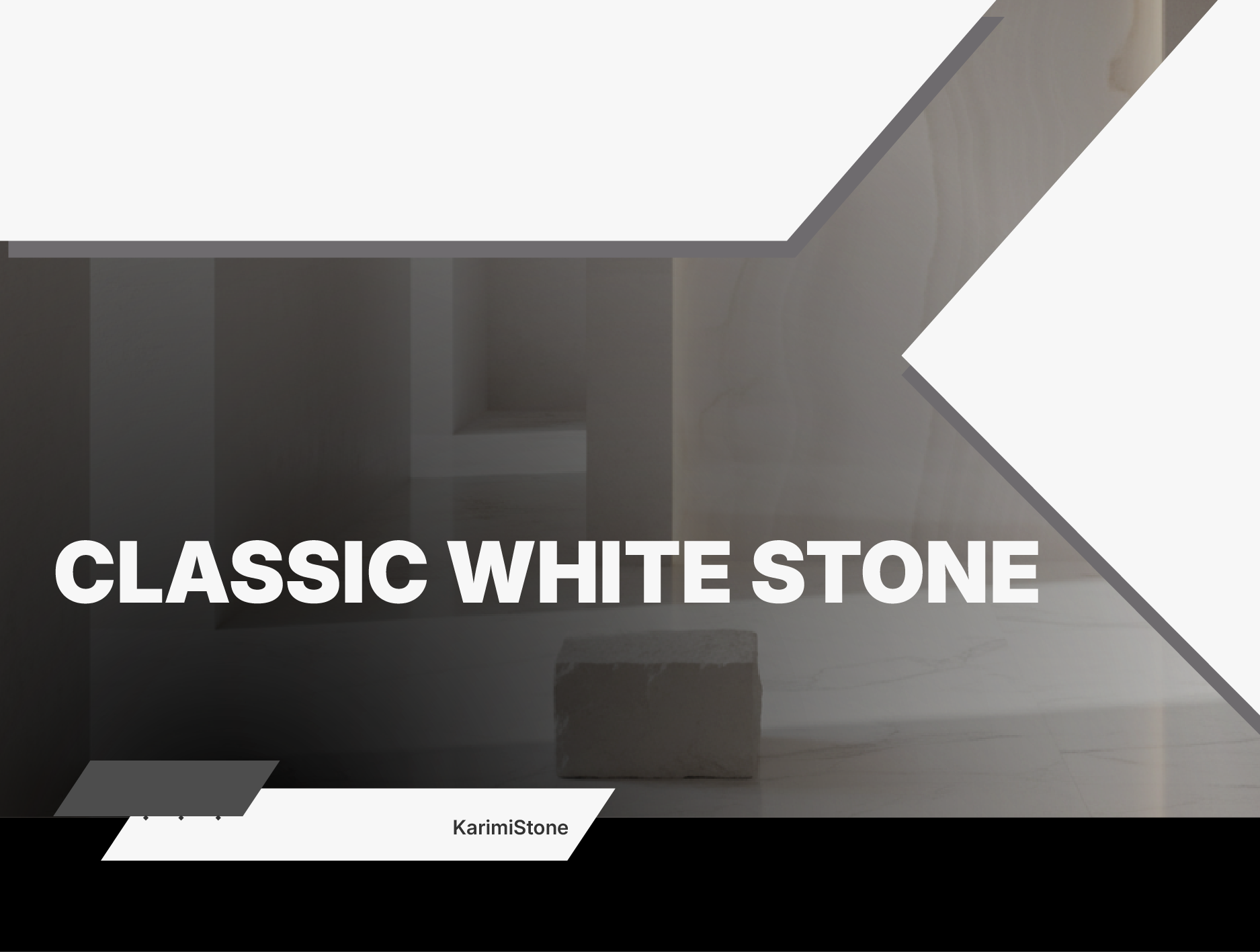
Post Page
Classic White Stone: Why Is It Still Popular?

Introduction
White stone has long been a symbol of purity, simplicity, and natural grandeur.
From the marble columns of ancient Greek temples to the stone walls of European palaces and the minimalist projects of the 21st century, the color white has always been the common language of beauty in architecture.
In today’s world, with the return of minimalist, Scandinavian, and neoclassical design trends, we are witnessing a new rise of white stones in both interior and exterior architecture.
But here is the interesting point: this popularity is not limited only to marble.
All families of white stone — from limestone and travertine to granite, quartzite, and onyx — each have their own unique role in expressing “luxury simplicity.”

The Universal Language of Simplicity and Purity
White is the universal language of light and balance.
In color psychology, white conveys a sense of order, purity, and focus.
When this quality appears in the form of natural stone, the result is a combination of pure beauty and the power of the earth.
White stones, in each of their types, retell this language in their own way:
- White marble, with its soft gray veins, has a poetic and classical look.
- White limestone, with its smooth surface and soft color, creates a natural and minimal feeling.
- White travertine, with its natural holes, keeps the warmth and honesty of the raw material.
- White granite is hard, glossy, and long-lasting — a choice for durability.
- White quartzite has a luxurious and resistant look similar to marble, but it is unmatched in hardness.
- White onyx, by letting light pass through, brings a spirit of delicacy and transparency to the space.
Exceptional Compatibility with Design Styles
One of the most important features of white stone is its adaptability to all styles.
In modern design, white creates a neutral and calm background that allows other elements to shine.
In classic style, it combines with warm light and golden materials to show grandeur and historical depth.
Combining white stone with wood, dark metal, or concrete can create a balanced contrast — a contrast between warmth and coolness, between nature and technology.
From luxury hotel lobbies in Dubai to modern villas in Scandinavia, white is always present as a reliable and inspiring base.
Return to Nature and the Sense of Earth
In a world full of artificial materials, designers look for a material that brings “life” back into the space.
- White stone, with its natural origin, tells a story of time, pressure, and the earth in every texture and vein.
- Marble gives the feeling of nature’s luxury.
- Limestone has an earthy and calming feeling.
- Travertine brings a natural and organic sense to the space.
- Onyx turns light into life.
- Each of these stones, in its own way, is a reflection of nature — not an imitation of it.
The Role of Light in the Splendor of White Stone
No stone has such a poetic relationship with light as white stone.
Its bright surface and soft veins absorb and reflect light and make the space look more alive.
In interior design, light and white stone are two complementary elements:
- Warm light makes white softer and more intimate.
- Cool light gives it a more modern and cooler appearance.
In stones like white onyx, light can pass through the inside and turn the space into an artistic piece.
In fact, light is the painter of white stone.
Variety of Finishes and Textures in White Stones
One of the reasons for the lasting popularity of white stone is its ability to be finished in different ways.
Each type of finish shows a different character of the stone:
|
This variety makes it possible for every type of white stone to be used correctly in any environment — from homes to hotels or office spaces.
Creative Uses of White Stone
Combining contrasts: next to dark materials, glass, or warm wood to create balance.
Hidden or linear lighting: to highlight the natural texture.
Use in furniture and details: sinks, tables, decorative frames, or even art pieces.
Playing with thicknesses: using thinner stones for décor and thicker ones for structure.
Combining different whites: for example, marble on the floor, limestone on the wall, and onyx in the focal point of the space.
Analytical Conclusion: Why Are All Types of White Stone Popular?
In the final analysis, the popularity of white stone is not limited only to its appearance, but goes back to its three fundamental qualities:
- Natural light and brightness: no color can make a space look more open than white.
- Adaptability and texture variety: from marble to travertine, each has its own character.
- And most importantly: white is a color that does not get old in design.
In other words, white stone will not only be alive for today, but also for future generations.
Final Result
White stone, in all its forms — from marble to quartzite — is a symbol of simplicity, durability, and authenticity.
If we consider design as a language for expressing space, white is the word that, from ancient times to the modern age, has always had a clear meaning —
the language of light, purity, and timeless elegance.
Global Classification of White Stones
White stones, at the international level, are divided into several groups based on their geological origin and technical features:
White Marble
Marble is the result of metamorphism of limestone under high pressure and temperature, and because of its veins and natural polish, it is considered one of the most beautiful architectural stones.
Global examples:
- Carrara Marble (Italy): the most famous type of white marble with soft gray veins; a classic symbol of design.
- Volakas (Greece): white with diagonal purple and gray veins; popular in modern luxury design.
- Bianco Lasa (Italy): bright, pure, and very dense; suitable for minimal spaces.
- Ariston & Thassos (Greece): pure white with high brilliance.
- Persian Scato Marble – A refined dark grey marble with fine white veins, offering a modern and elegant look for interior walls and flooring.
- Aligudarz Marble – A light grey to white marble with subtle linear veins, known for its purity, smooth texture, and versatility in both classic and contemporary designs.
Application: flooring, wall cladding, countertops, bathrooms, lobbies, and luxurious spaces.
White Limestone

Limestone is a natural and sedimentary stone with a more matte appearance than marble. It has a more natural and minimal feeling and is often chosen for facades and calm spaces.
Examples:
- Gohare Limestone (Iran): soft texture, light cream to white color, suitable for interior facades.
- Moca Cream (Portugal): with horizontal veins and warm color.
- Vanak White (Iran): light limestone with a smooth and beautiful surface.
Application: interior and exterior facades, wall cladding, light flooring, luxury projects with plenty of natural light.
White Granite
Granite is technically harder and more resistant than marble and is an excellent choice for high-traffic areas.
Examples:
- Kashmir White (India): white grains with purple veins.
- Bianco Antico (Brazil): white with silver and gray spots.
- White Galaxy (India): bright white with shiny crystals.
- Panda White (China): strong contrast of white and black with a graphic appearance.
- Morvarid White Granite (Iran): Strong and durable light-grey stone with black and white grains, known for special look. It’s widely used for floors, stairs, facades, and urban paving due to its high resistance to weather and wear.
- Natanz White Granite (Iran) – Light grey to white granite with fine black spots, a popular choice for urban and commercial projects.
Application: kitchen, commercial flooring, outdoor spaces, and high-resistance projects.
White Onyx
A semi-transparent and precious stone that allows light to pass through. Each slab is unique.
Examples:
- Persian White Onyx (Iran): clear white with golden veins.
- Afyon White Onyx (Turkey): crystalline structure and natural shine.
Application: decorative walls, interior backlighting, luxury counters, artistic spaces.
White Travertine
A porous stone with a horizontal band pattern; lighter than marble and resistant to environmental conditions.
Examples:
- White Travertine (Iran): with cloudy texture and natural holes, popular in Russia and Europe.
- Navona Travertine (Italy): warm color, soft and classic structure.
Application: facades, landscaping, interior walls, yard flooring, and corridors.
White Quartzite
One of the hardest natural stones with crystalline shine and very high resistance.
Examples:
- Taj Mahal (Brazil): luxurious look similar to marble but more resistant.
- Super White (South Africa): white-gray with natural texture and high hardness.

Application: kitchen countertops, bathrooms, and high-traffic spaces.
20 Professional Questions with Answers
- What is the main reason for the popularity of white stone?
The combination of natural beauty, light reflection, and harmony with any design style. - What is the main difference between marble and limestone?
Marble is metamorphosed and denser; limestone is sedimentary and softer. - Which type of white stone is more suitable for high-traffic areas?
White granite or white quartzite. - Why is white travertine used in facades?
Because of its porosity and resistance to temperature changes. - Which white stone has the highest brilliance?
White onyx, because of its light-transmitting property. - Is limestone suitable for wet areas?
No, because it is porous and should be used with protective coating. - Which countries are the top producers of white marble?
Italy, Greece, Iran, and Turkey. - Why is white stone a good choice for small spaces?
Because of its high reflection and ability to make the space look brighter. - Which white stone is suitable for backlighting?
White onyx or white quartzite. - In which styles does white stone play a key role?
Minimal, classic, neoclassical, and Scandinavian. - Why is the combination of white with wood effective?
Because the contrast between the warmth of wood and the coolness of white creates visual balance. - Is white marble suitable for outdoor areas?
Only if used with anti-absorption and proper sealing. - Which Iranian white stones are popular in the Russian market?
White travertine and Gohare limestone. - What is the visual difference between Carrara and Volakas?
Carrara has soft gray veins; Volakas has diagonal and sometimes purple veins. - Can white stone be recycled?
Yes, it can be reused in new projects as stone powder or cut pieces. - What is the final message of designing with white stone?
White means balance, clarity, and timeless beauty — the universal language of design.
40 Technical Stone Terms with English Definitions
- Metamorphic Rock – A type of rock that forms when existing rock changes under high heat and pressure; marble is a metamorphic rock derived from limestone.
- Sedimentary Rock – Rock formed by the accumulation of sediments, usually in layers; examples include limestone and travertine.
- Igneous Rock – Rock created from cooled magma or lava; granite is a common example used in construction.
- Porosity – The percentage of tiny holes or voids within a stone that determines how much water it can absorb.
- Veining – Natural lines or streaks in stone caused by mineral deposits, giving marble and onyx their unique appearance.
- Crystalline Structure – The arrangement of mineral crystals within the stone that defines its strength, shine, and texture.
- Translucency – The ability of a stone, such as onyx, to allow light to pass through its surface.
- Backlighting – A lighting technique used behind translucent stones to highlight their internal patterns and colors.
- Stone Finish – The final surface treatment applied to stone to achieve a specific texture or appearance.
- Polished Finish – A smooth, glossy finish that reflects light and emphasizes the color and veining of the stone.
- Honed Finish – A matte, non-reflective surface that feels smooth but not shiny; often used in modern interiors.
- Brushed Finish – A lightly textured surface created by brushing, giving a natural and slip-resistant feel.
- Sandblasted Finish – A rough surface created by blasting sand at high pressure, often used for exterior or anti-slip applications.
- Split-Face Finish – A rough, uneven surface that shows the natural break of the stone; used in decorative and façade walls.
- Compressive Strength – The maximum amount of load or pressure a stone can bear before breaking.
- Flexural Strength – The ability of a stone slab to resist bending forces, important for façades and countertops.
- Abrasion Resistance – The stone’s capacity to withstand wear and friction from foot traffic or physical contact.
- Water Absorption – The percentage of water that a stone can absorb; lower values mean better durability.
- Density (Specific Gravity) – The mass of the stone compared to its volume; higher density means stronger and less porous stone.
- Thermal Expansion – The tendency of a stone to expand or contract when exposed to temperature changes.
- Weather Resistance – The stone’s ability to resist damage from rain, frost, sunlight, and other outdoor conditions.
- Slip Resistance – The level of friction a surface provides to prevent slipping, essential for floors and outdoor paving.
- Cross-cut / Vein-cut – Two cutting directions for stones like travertine: crosscut (perpendicular to veins) and vein cut (parallel to veins).
- Block – A large solid piece of raw stone extracted directly from the quarry before processing.
- Slab – A large, flat sheet cut from a stone block, typically used for countertops, walls, and floors.
- Tile / Paver – Smaller, thinner pieces of stone used for flooring, pathways, and wall coverings.
- Cladding – The process of covering a building’s surface with stone to improve appearance and protection.
- Joint (Stone Joint) – The gap or seam between two stone units that allows for installation, expansion, and sealing.
- Sealer / Sealing – A protective liquid applied to stone surfaces to prevent water absorption and staining.
- Calcite – The main mineral found in limestone and marble; responsible for their polish and softness.
- Quartz – A very hard mineral found in granite and quartzite; adds strength and scratch resistance.
- Feldspar – A group of minerals in granite that influence its color and light reflection.
- Dolomite – A mineral similar to calcite but slightly harder; found in dolomitic limestone and marble.
- Fissure – A natural hairline crack or fracture in stone that occurs during formation; often filled during processing.
- Book-matching – A technique of placing two stone slabs side by side so that their veining patterns mirror each other like an open book.
- Porous Filling – The process of filling holes and pores in travertine with resin or cement for a smoother surface.
- Grain Size – The size of mineral crystals or particles in stone; larger grains affect both texture and strength.
- Color Variation – Natural differences in shade or tone that give each piece of stone a unique character.
- Thermal Shock Resistance – The stone’s ability to resist cracking when exposed to sudden temperature changes.
- Quarrying – The extraction process of cutting and removing large stone blocks from a quarry for further processing.
Sources Used
- Marmomac Journal – “Global White Stones and Market Trends” (2025)
- Italian Trade Agency – “White Marble & Limestone Markets”
- Interior Design Magazine – “How White Stones Define Luxury Interiors”









 Online Catalogue
Online Catalogue
